The Complete Home Gym Buying Guide: From Beginner to Pro (2025)
Building a home gym is one of the best investments you can make in your fitness journey.
Whether you're tired of crowded commercial gyms, want to save on membership fees, or simply prefer working out at home, this guide will help you create the perfect training space for your needs and budget.
What Size Space Do You Need for a Home Gym?
The amount of space you need depends entirely on your training goals:
Minimal Setup (50-75 sq ft): Perfect for a bedroom corner or small garage space. You can fit adjustable dumbbells, a weight bench, resistance bands, and a yoga mat. This works great for bodyweight training, dumbbell exercises, and stretching.
Basic Weight Training Setup (100-150 sq ft): Ideal for a spare bedroom or single-car garage. This allows for a power rack or squat stand, barbell with plates, adjustable bench, and some cardio equipment like a rowing machine. You'll have enough room for compound movements like squats, bench press, and deadlifts.
Full Training Center (200+ sq ft): Best for a two-car garage or basement. At this size, you can include multiple training stations, cardio equipment, a functional trainer, specialty bars, dumbbell sets, and dedicated areas for different workout styles.
Don't forget about ceiling height. You'll need at least 8 feet for most exercises, but 9-10 feet is ideal if you're tall or plan to do overhead movements with barbells.
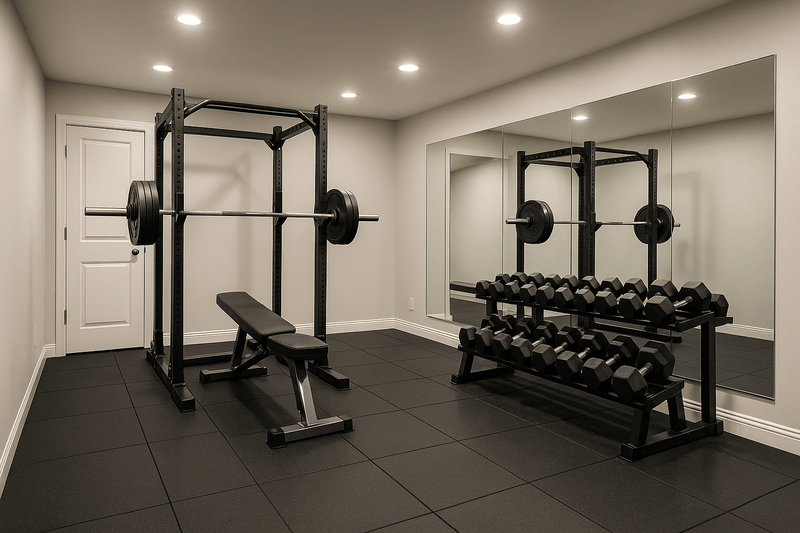
What Equipment Should You Buy First?
Start with versatile equipment that allows for the most exercises. Here's the priority order for most people:
Priority 1: Adjustable Dumbbells or Dumbbell Set
Dumbbells are incredibly versatile and work for nearly every muscle group. If space is tight, adjustable dumbbells can replace an entire rack. For dedicated gyms, a hex dumbbell set from 5-50 lbs covers most people's needs. Check out options like the Body-Solid Rubber Hex Dumbbell Sets or TKO Rubber Hex Dumbbells with Rack. These typically cost $1-2 per pound, so expect $500-1,500 for a complete set.
Priority 2: Quality Weight Bench
An adjustable bench that goes flat, incline, and decline opens up dozens of exercises. Look for sturdy construction (500+ lb weight capacity), comfortable padding, and multiple adjustment angles. Budget $200-400 for a solid bench that will last years.
Priority 3: Power Rack or Squat Stand
This is your safety system for heavy lifting. A power rack (also called a squat cage) provides safety bars for squatting and benching alone. Budget options like the Best Fitness BFPR100 Power Rack start around $400, while commercial-quality racks like the Vortex Strength SRVXG350 Power Cage or Body-Solid GPR400 run $800-2,000. Squat stands are more affordable ($200-400) but offer less versatility.
Priority 4: Barbell and Weight Plates
A 45 lb Olympic barbell is standard for serious lifting. Look for a bar rated for at least 700 lbs. Browse our barbells collection for quality options. For plates, rubber-coated options are quieter and protect floors better than bare iron. A starter set with a barbell and 300 lbs of plates typically costs $400-700.
Priority 5: Rubber Flooring
Often overlooked but essential. Rubber flooring protects your concrete, reduces noise, and provides cushioning.
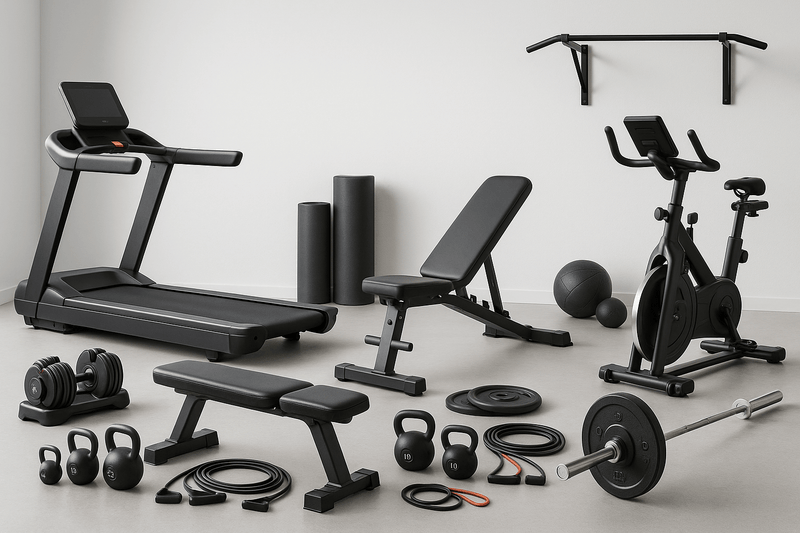
How Much Should You Budget for a Home Gym?
Here are realistic budget ranges based on training goals:
Starter Setup ($500-1,500): Adjustable dumbbells, resistance bands, yoga mat, jump rope, and basic bench. Great for general fitness and maintaining strength.
Intermediate Setup ($2,000-5,000): Power rack, Olympic barbell, 300 lbs of plates, adjustable bench, pull-up bar, rubber flooring, and possibly a rowing machine or assault bike. This covers serious strength training. Consider a complete package like the Vortex Strength Power Rack Full Set which includes everything you need.
Advanced Setup ($5,000-15,000): Everything above plus specialty bars, complete dumbbell set, functional trainer, multiple cardio options, recovery tools like a sauna or massage chair, and premium finishes.
Elite/Commercial Setup ($15,000+): Multiple training stations, full plate-loaded machines, extensive cardio options, turf area, specialized equipment for sports training, and professional-grade everything.
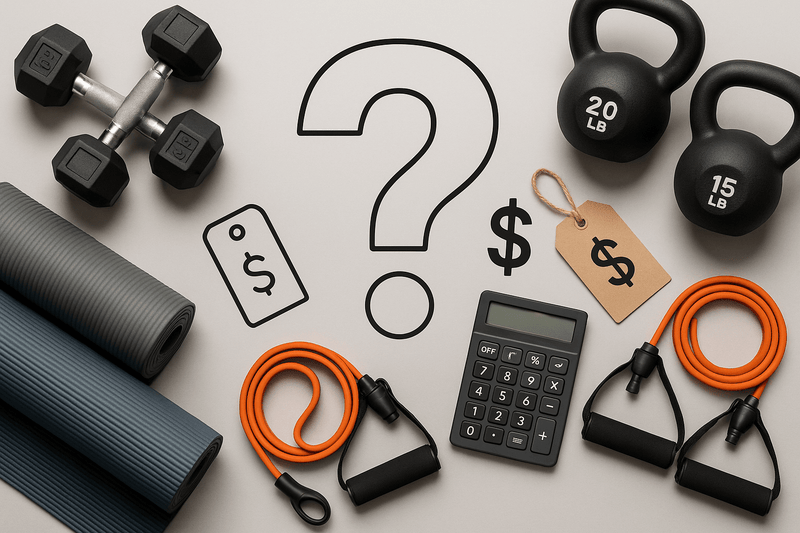
Power Rack vs Squat Stand: Which Should You Choose?
This is one of the most common questions when building a home gym.
Choose a Power Rack if:
- You train alone and need safety bars for heavy squats and bench press
- You have the space (typically needs 8-10 ft of floor space)
- You want options for attachments like dip bars, landmines, or lat pulldown systems (check out the Body-Solid U-Link Attachment for added versatility)
- Your budget allows for $500-2,000
- You plan to train for years and want one solid piece
Popular choices include:
- Budget-Friendly: Best Fitness BFPR100 ($400-600 range, 500 lb capacity)
- Premium All-in-One: Vortex Strength SRVXG350 (includes lat pulldown, 1,400 lb capacity)
- Commercial-Grade: Body-Solid Pro Club Line SPR1000 (1,000 lb capacity, expandable)
Choose a Squat Stand if:
- Space is limited and you need something more compact
- You primarily train with a partner who can spot you
- Budget is tight ($200-400)
- You want equipment that's easier to move around
- You're focusing on Olympic lifting where you'll bail weights anyway
Browse our full squat rack collection to compare options.
Most serious home gym owners prefer power racks for the safety and versatility, but squat stands work great for experienced lifters who know their limits. For a detailed comparison of specific models, check out USA Sports Outlet's Best Power Racks guide.
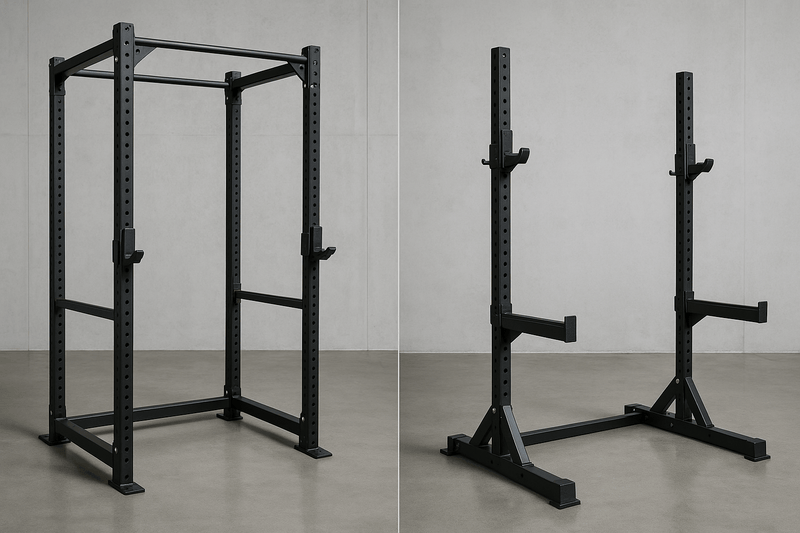
What Mistakes Do People Make When Building a Home Gym?
Buying cheap equipment that breaks quickly: That $200 bench from a big-box store will wobble and fail within a year. Buy quality once rather than replacing cheap equipment multiple times.
Not measuring their space properly: Know your dimensions before ordering. A rack that's 6 inches too tall for your ceiling is useless. Account for loading plates onto bars (you need 2-3 feet on each side of a barbell).
Ignoring flooring: Dropping weights on concrete damages both the weights and the floor. It's also loud enough to upset neighbors or family. Invest in proper flooring from day one.
Buying too much cardio equipment: Treadmills, ellipticals, and bikes take up huge space and often become clothes hangers. If you want cardio, a rowing machine or assault bike offers better workouts in less space.
Not planning for noise: Rubber bumper plates and quality flooring reduce noise significantly. If you're in an apartment or have close neighbors, this matters more than most people realize.
Forgetting about ventilation: Gyms get hot fast. A fan or proper ventilation is essential, especially in garages. Consider a portable AC unit for summer training.
Do You Need Rubber Plates or Iron Plates?
Both have advantages depending on your training style:
Iron Plates are better if:
- You're on a tight budget (they're 30-50% cheaper)
- You never drop weights from overhead
- Space on your barbell is limited (iron is thinner than rubber)
- You prefer the traditional gym aesthetic
Rubber/Bumper Plates are better if:
- You do Olympic lifts (clean, snatch) and need to drop weights
- Noise reduction matters
- You want to protect your floors
- You prefer safer equipment (rubber won't crack or chip like iron)
For most home gyms, rubber-coated iron plates are the sweet spot. They're quieter than bare iron, protect floors better, and cost less than full bumper plates.
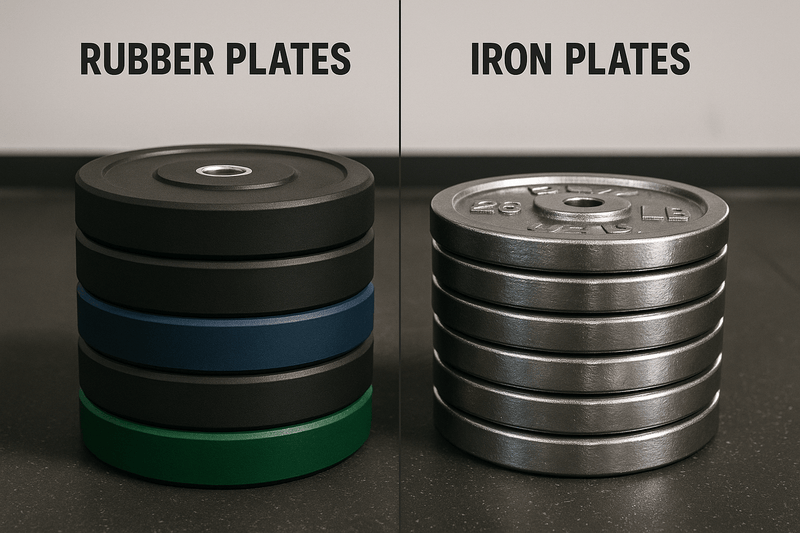
How Do You Choose Between Different Cardio Equipment?
Each type serves different purposes:
Rowing Machine: Full-body workout, low impact, small footprint. Best for people who want efficient cardio that also builds muscle. Concept2 is the gold standard ($900-1,200). Check out our cardio equipment for options.
Assault Bike: Brutal conditioning, works upper and lower body, nearly indestructible. Perfect for HIIT training and metabolic conditioning. Takes up little space but it's loud.
Treadmill: Most natural running experience indoors. Takes up significant space (usually 6-7 ft long) and expensive models ($2,000+) are needed for serious running. Budget options often fail quickly.
Elliptical: Gentle on joints, easy to use, but takes up lots of space. Best for people with knee or hip issues who can't run or row comfortably.
Stationary Bike: Quiet, low impact, and great for steady-state cardio. Peloton-style bikes offer classes but require subscriptions. Basic bikes are affordable ($300-500).
For most home gyms with limited space, a rowing machine or assault bike provides the best workout per square foot.
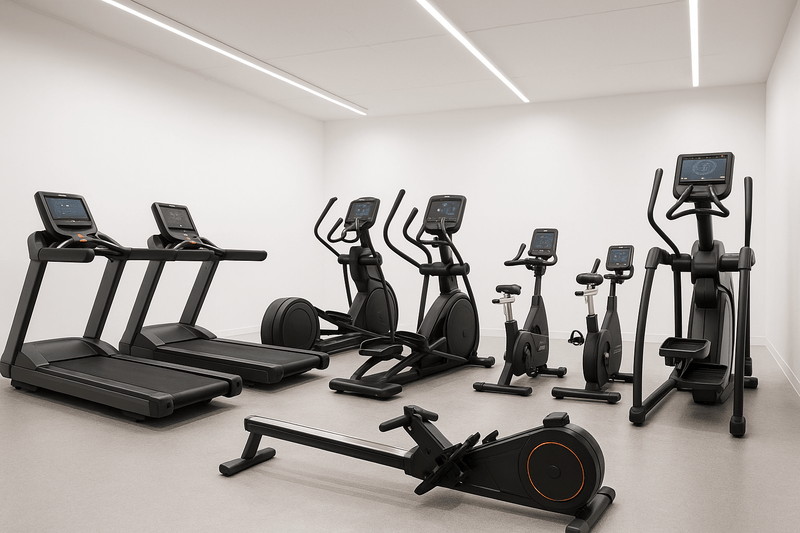
What About Recovery Equipment?
Recovery tools are often overlooked but crucial for long-term progress:
Foam Roller ($15-50): Essential for every gym. Helps with muscle soreness and mobility. Start here.
Massage Gun ($100-600): Provides targeted deep tissue work. Theragun and Hypervolt are premium brands, but budget options work fine for most people.
Infrared Sauna ($1,500-5,000): Improves recovery, cardiovascular health, and relaxation. Low-EMF models are healthier. Consider size carefully—a 1-2 person sauna needs about 30-40 sq ft. Our Dynamic Barcelona Low EMF Infrared Sauna is perfect for home use.
Cold Plunge ($500-5,000): Growing in popularity for reducing inflammation and improving mental toughness. DIY chest freezer setups are budget-friendly, while dedicated units offer better temperature control.
Stretching Tools: Yoga blocks, resistance bands, and stretching straps cost under $100 total and significantly improve flexibility and injury prevention.
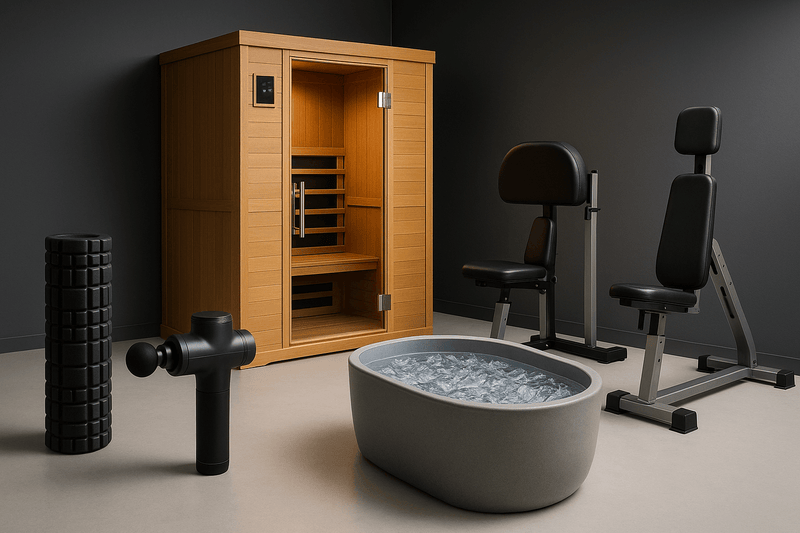
How Long Does It Take to Set Up a Home Gym?
Planning and ordering: 1-2 weeks to research, measure, and order equipment
Flooring installation: 2-4 hours for a 200 sq ft space with rubber mats
Equipment assembly: Plan for these timeframes:
- Power rack: 2-3 hours
- Weight bench: 30 minutes to 1 hour
- Cardio equipment: 1-3 hours depending on complexity
- Dumbbells and plates: Minimal assembly (just organize them)
Total setup time: Most people can have a fully functional basic home gym ready in a weekend, assuming equipment arrives on schedule.
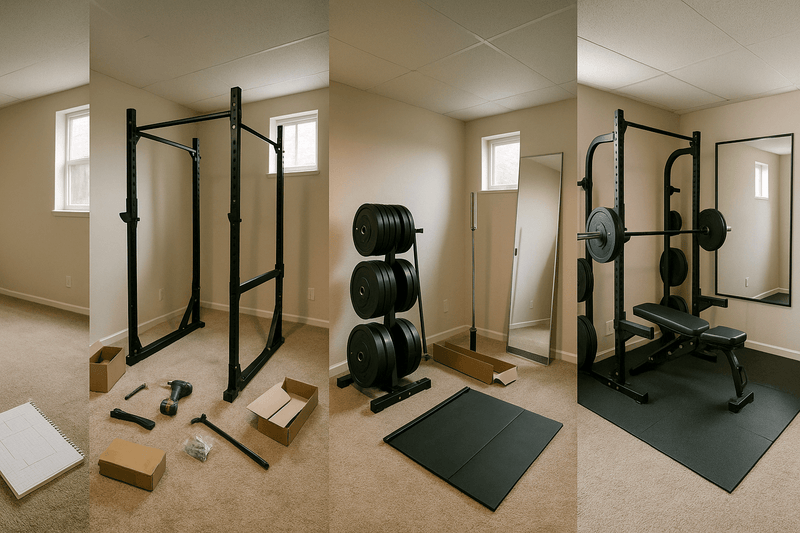
What's the Return on Investment for a Home Gym?
A commercial gym membership averages $50-100 per month. That's $600-1,200 per year, or $3,000-6,000 over five years.
A quality home gym setup costing $3,000-5,000 pays for itself in 3-5 years, after which you're training for free. Plus you save:
- Commute time (30-60 minutes per workout)
- Gas money
- Waiting for equipment during busy hours
- Gym membership fees during travel
The convenience factor alone is worth thousands to most people. Working out at home means no excuses about traffic, weather, or gym hours.
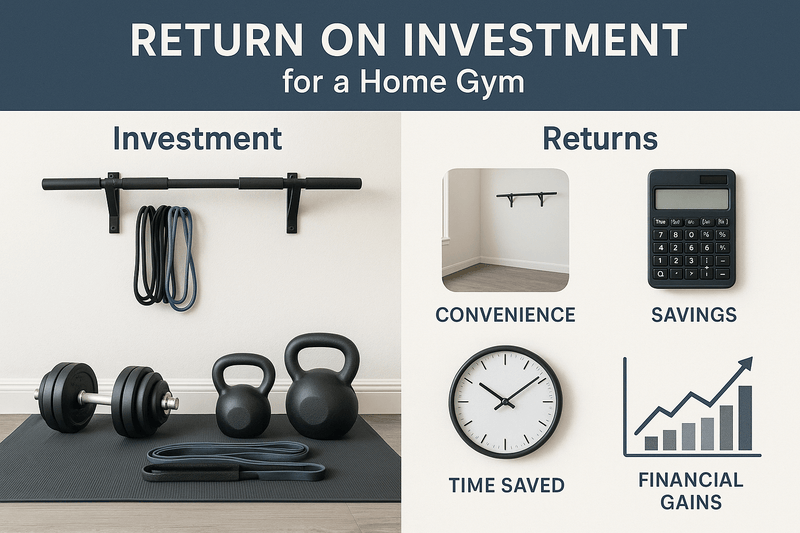
What Should You Look for in Commercial-Grade vs Home-Use Equipment?
Commercial-grade equipment is built for constant use by hundreds of people. It features:
- Heavier steel construction
- Higher weight capacities (often 1,000+ lbs)
- More durable upholstery and powder coating
- Longer warranties (often 10+ years on frames)
- Higher cost (typically 2-3x more expensive)
Home-use equipment is designed for 1-2 hours of daily use by a few people:
- Lighter construction (but still durable)
- Weight capacities of 500-800 lbs (plenty for most people)
- Shorter warranties (1-5 years typical)
- More affordable pricing
For home gyms, high-quality home-use equipment is usually the right choice. You don't need commercial-grade unless you're outfitting a facility with multiple users or planning to resell later.
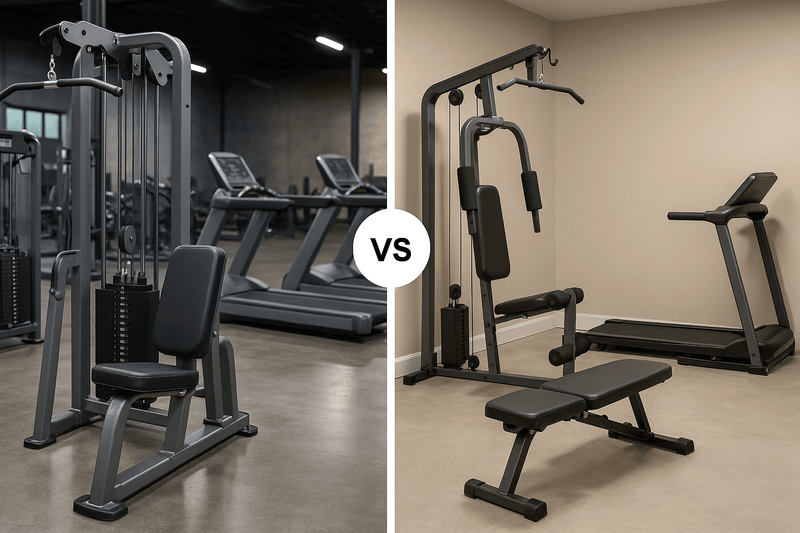
Ready to Build Your Dream Gym?
The key to a successful home gym is starting with quality fundamentals and expanding over time.
Featured Complete Home Gym Solutions:
Looking for a complete package? Consider these all-in-one solutions:
- Vortex Strength Power Rack Full Set: Includes power cage, barbell, 245 lbs of plates, and adjustable bench
- Vortex Strength SRVXG350 with Lat Pulldown: All-in-one solution with cable system and attachments
- Body-Solid Complete Systems: Commercial-grade options for serious lifters
Essential Equipment by Category:
- Power Racks & Squat Racks: From budget-friendly to commercial-grade
- Dumbbell Sets: Adjustable and fixed weight options
- Barbells & Weight Plates: Olympic bars and rubber-coated plates
- Recovery Equipment: Saunas, massage tools, and more
- Premium quality equipment from top brands
- Custom gym design and layout consultation
- Professional installation and setup
- Ongoing support and maintenance
Get Your Free Consultation
Why Choose USA Sports Outlet
At USA Sports Outlet, we help hundreds of customers design home gyms every month. Our team can provide free gym design consultations to maximize your space and budget.

